Before treatments for gingivitis and subsequent periodontal disease are considered, the veterinary professional must contemplate exactly what is meant by the term periodontal disease. The disease is frequently referred to as gum disease as this is what clients will be better able to relate to from a terminology perspective, and it encompasses all plaque-associated disease processes that affect the peridontium. The most common category of periodontal disease is what some would call ‘adult-onset’ periodontal disease, as it tends to affect adult animals and the process begins with, and progresses due to the accumulation of plaque and bacteria (Gorrel, 2004). Periodontal disease affects many cats and dogs to some degree, so one should assume that every animal that walks through the practice door is affected by the disease until proven otherwise.
Managing periodontal disease can be quite a challenge for veterinary professionals because it is progressive and there is not one thing that can be done to prevent its development or halt its progress. Management strategies involve trying to reduce the amount of plaque present within the oral cavity of the patients via oral homecare techniques and products, which will in turn reduce the damage caused by plaque and the patient's response to its presence (Gorrel, 2004). It must be borne in mind that some animals will be much more severely affected by plaque than others, as host response to plaque's negative effect on the adjacent tissues is individual and can be exacerbated by underlying conditions/pathology too; this can make plaque control and oral health maintenance infinitely more difficult. The progression of periodontal disease is quite complex and is affected by a wide variety of factors besides plaque accumulation. Veterinary professionals must be aware of the aetiology and pathogenesis of the condition in depth to be able to truly help all patients; a person knowledgeable about the progression of a condition or disease is in a much better position to advise about preventative/management techniques, and thus really make a difference to the patient's health overall.
Plaque
Every tooth is covered by a pellicle, which is an acellular membrane coating the enamel surface; plaque is able to adhere to this pellicle. Salivary glycoproteins and typically non-pathogenic/commensal bacteria form on the tooth surface, which is called a biofilm (the correct term for plaque), with the addition of polysaccharides produced by some bacteria (Figure 1). The biofilm's structure protects the bacteria within, thus making their destruction with antibiotics very difficult, and the layers of these substances will simply multiply as the tooth is a non-shedding surface. As this accumulation matures the biofilm changes in composition with Gram-positive aerobic bacteria changing to Gram-negative anaerobic bacteria, which produce noxious and toxic waste materials due to their metabolic processes. These toxins cause inflammation of any tissue they are in contact with, namely the tissues of the gingival margin and sulcus (Gracis, 2013).
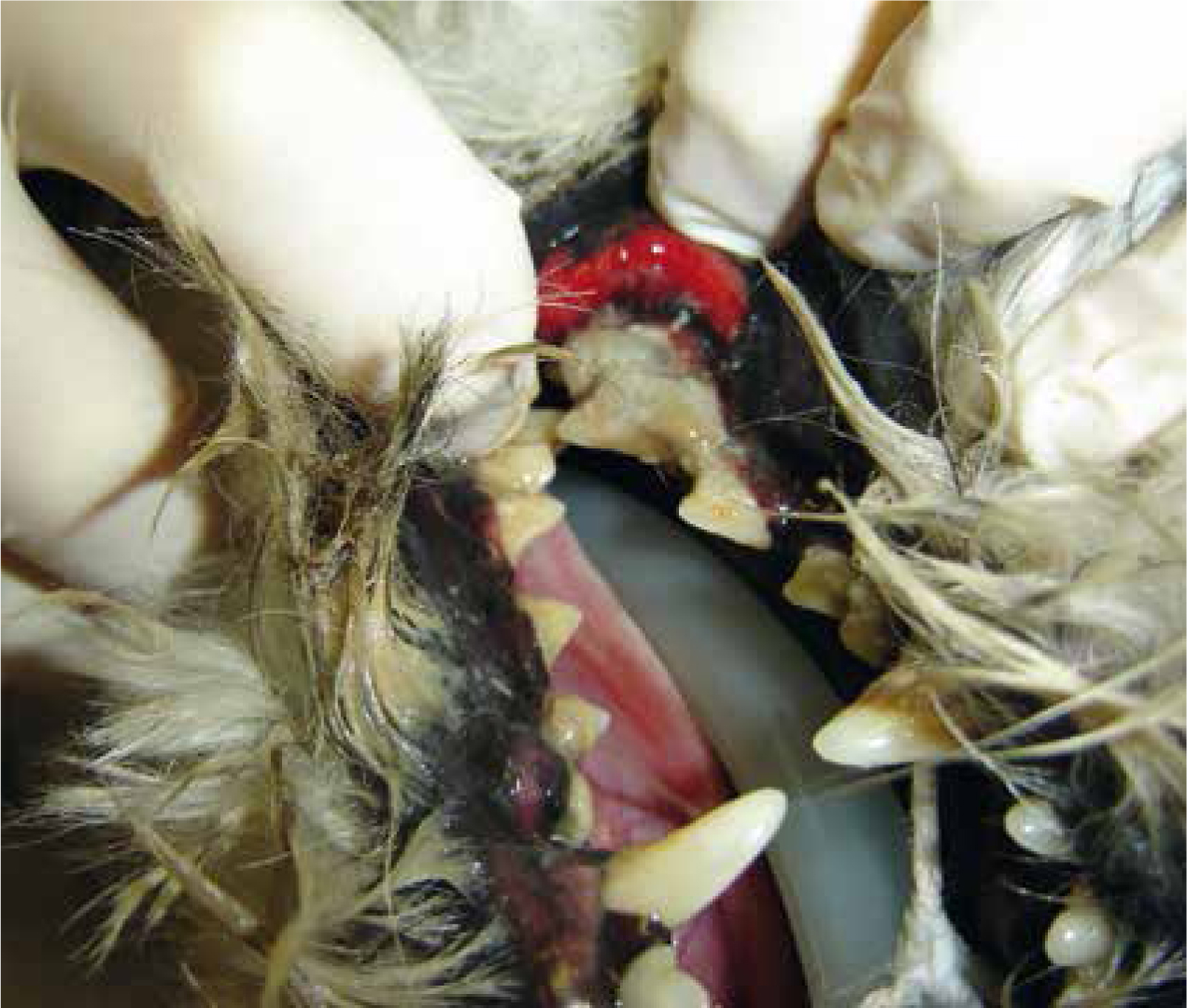
Veterinary professionals must be mindful that plaque does not form because food passes through the oral cavity, it begins forming as soon as tooth brushing ceases because all of the components to aid its accumulation are present on the tooth surface naturally. Sticky and carbohydrate-rich foods will however speed up the rate of plaque accumulation, which is one reason why dry/kibble diets are promoted for oral health management as opposed to wet/moist diets. Plaque accumulation can be seen along the gingival margin as a white, sticky substance and can be highlighted further with plaque disclosing fluids/dyes.
The most effective way to remove plaque and the associated bacteria is tooth brushing, ideally twice a day; the bristles of the brush sweep out the gingival sulcus, and the mechanical action of the bristles helps to disrupt the biofilm (Gorrel, 2004).
Calculus
Calculus is also known as tartar or sometimes ‘scale’ and is calcified plaque accumulations. Calcification occurs as a consequence of plaque being exposed to saliva and gingival crevicular fluid, both of which contain high levels of minerals (Niemiec, 2010). Calculus is not harmful, however it does adhere very strongly to the tooth surface and can only be removed by using calculus forceps and scaling techniques. It has a rough and porous surface within which plaque bacteria can reside, thus making their removal impossible, and can begin to form within 48 hours of plaque accumulation (Figure 2).
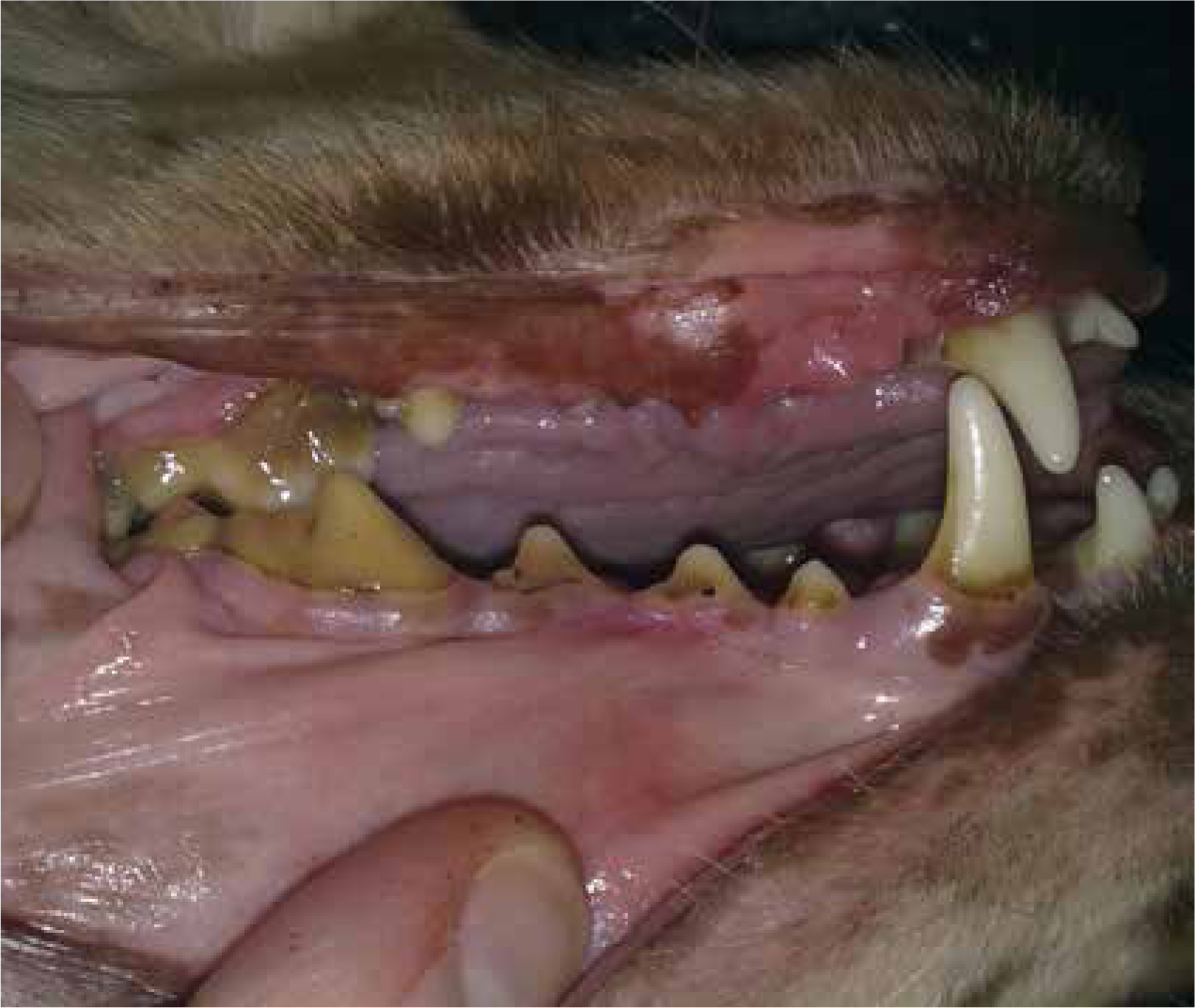
Gingivitis
Gingivitis means inflammation of the gingivae, which occurs as the first response of the gingivae to the insult/presence of plaque bacterial toxins on adjacent tooth surfaces (Figure 3). As the gingival tissue inflames the sulcus deepens, which allows more anaerobic bacteria to accumulate, increasing the flow rate of crevicular fluid and thus increasing the rate of plaque conversion to calculus. At this point, typically the gingivitis is non-painful and totally reversible so long as the plaque is removed; however, if the gingivitis is associated with another underlying condition then it may be painful. Gingivitis tends to be bilaterally symmetrical, however if this is not the case the veterinary surgeon should aim to take some biopsies of the tissue for histopathological examination by a pathologist who is qualified in oral tissue analysis (Holmstrom et al, 2013).
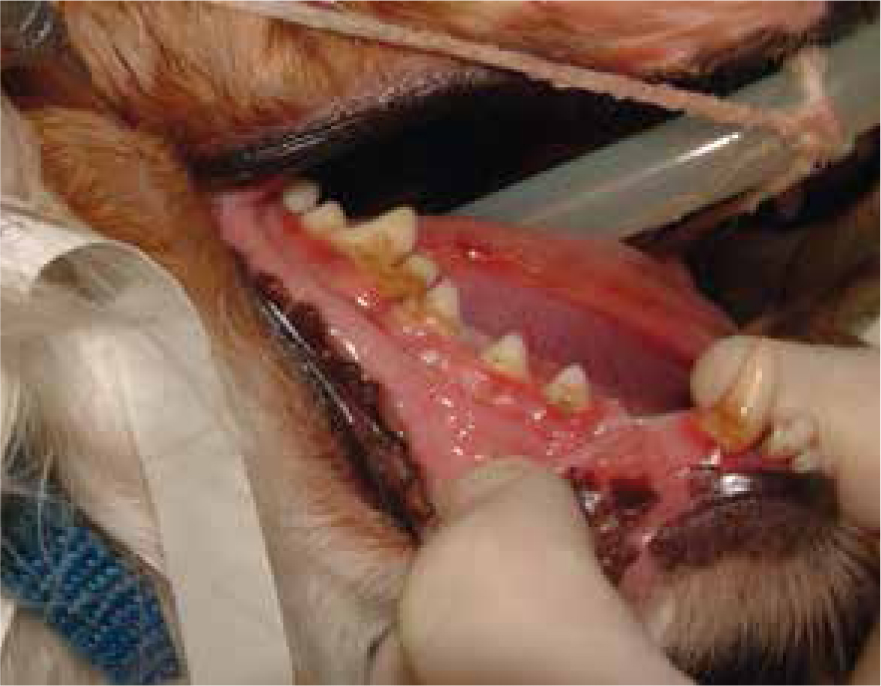
If the plaque is not removed the gingivae cannot recover from the insult and the gingivitis cannot resolve itself. When it becomes established and thus a more chronic situation, gingivitis can develop into periodontitis/periodontal disease. This process and the point of change differs between patients and it can take many years to actually progress to periodontitis in some animals, if ever, whereas in other patients it can be a relatively rapid process (Niemiec, 2010). In a typical case, the change will occur around the age of 3 or 4 years and it is not yet fully understood what features in or triggers the change/transition from one state to the other. It is however clear that gingivitis has to be present for periodontal disease to develop (Holmstrom et al, 2013), but the presence of gingivitis does not necessarily mean the periodontal disease will actually ever develop. Smaller dogs, cats and pure breed animals tend to develop periodontitis that starts at a younger age and usually progresses rapidly.
Periodontitis
At some point the pathology changes from gingivitis to periodontitis, and the animal then has periodontal disease. The change means that the simple type of inflammation present, which is chronic in nature, now causes tissue breakdown due to a change in the animal's response to the plaque. Figure 4 is a flow chart describing the progression of periodontitis from the point at which is becomes established to the point of tooth exfoliation (Gorrel, 2004).
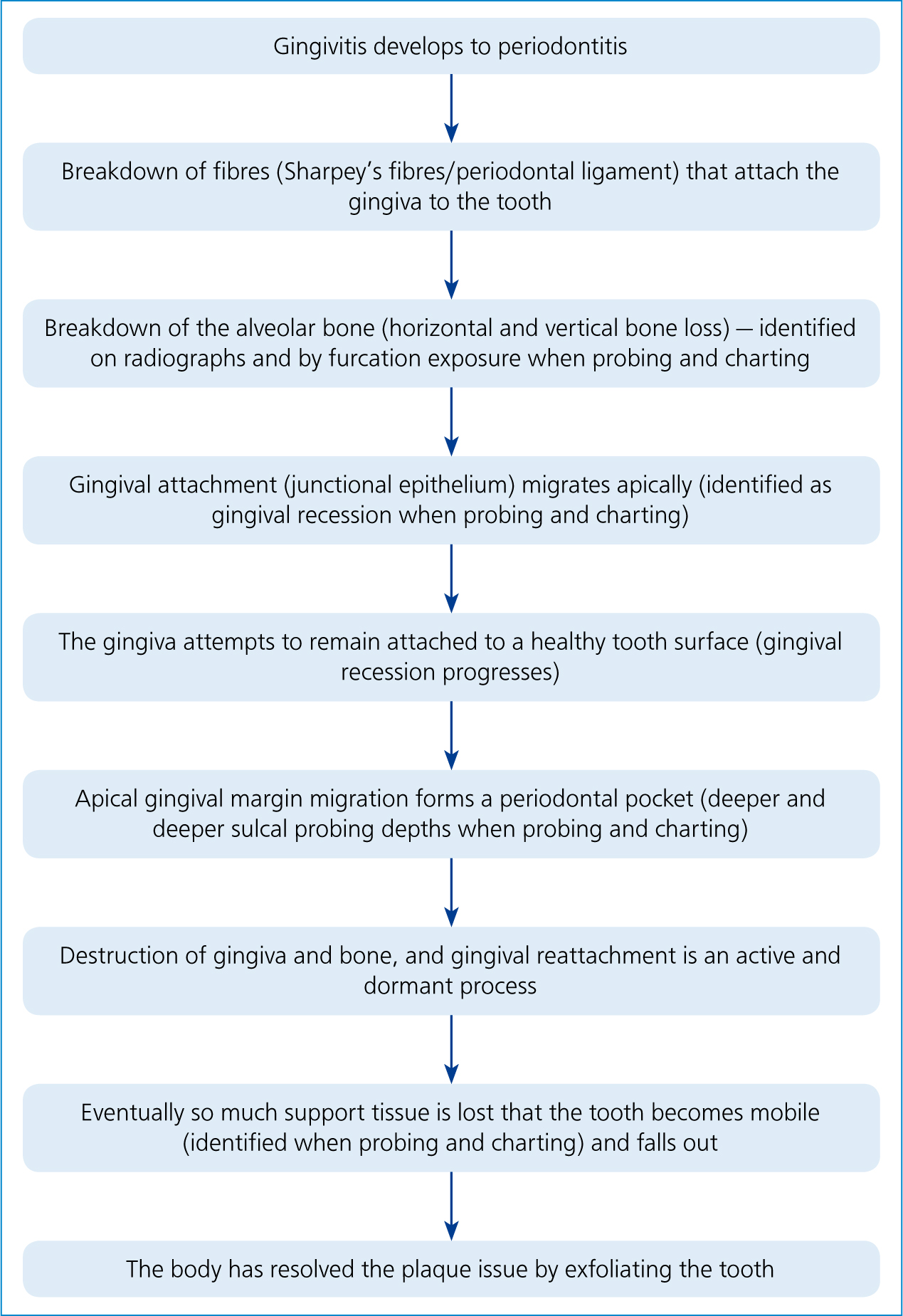
The changes associated with periodontitis, such as gingival recession, bone loss and furcation exposure, mobility, and very deep probing depths (Baxter, 2013) are irreversible and treatment should be planned to try and prevent or slow the destruction (Figure 5). Progression of periodontal disease gathers momentum and the more advanced the situation, naturally more is involved in relation to treatment and management. The rate of disease progression, as mentioned earlier, is influenced by many things and some animals will have naturally poorer oral health than others, which is the case in humans too. This means that they react to the presence of plaque in different ways and to differing extents, and factors thought to contribute to rapid disease progression include immune system function, body mass, diet and hormones, to name a few.
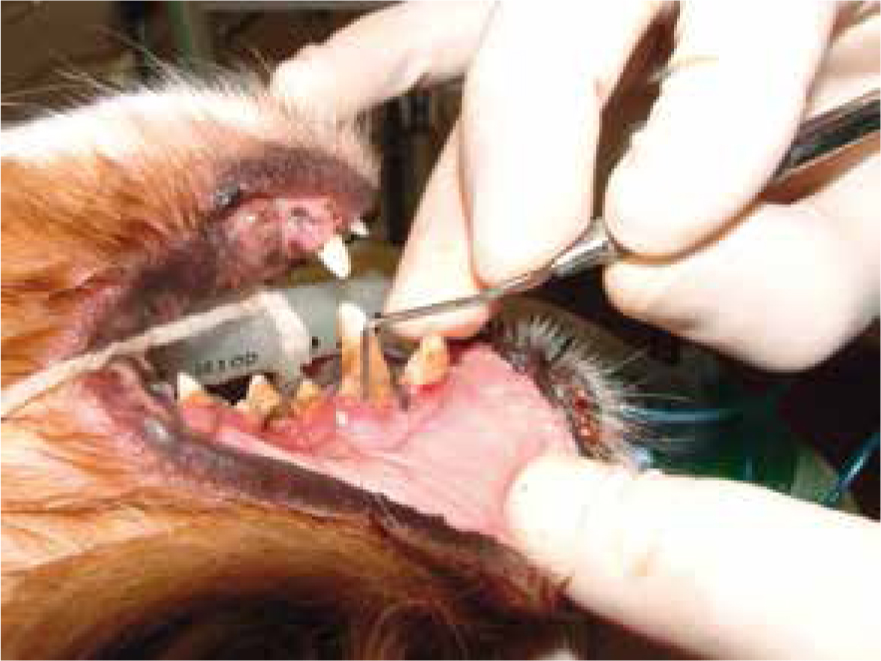
Consequences of periodontal disease
The consequences of periodontal disease include tooth loss via the process described in Figure 4, which in itself must be an uncomfortable and potentially painful process mainly due to the mobility of the affected dentition or the presence of a periodontal abscess as a result of the disease. The other significant consequence is repeated/sustained bacteraemias. The underlying tissue of the gingiva is very vascular and when the gingiva is inflamed to the extent it is in periodontitis there is a breach in the tissue and subsequently direct entry into the patient's blood stream (Perry and Tutt, 2015). Naturally, the bacteria and their toxins will migrate through this breach and into the bloodstream causing a bacteraemia. The body's natural defences can generally cope with this and will clear the invasion in around 20 minutes, however the influx of bacteria will occur every time the animal chews or even closes its mouth. Over time this ingress becomes so frequent that the body has to work harder to cope and it is thought that insidious changes in an animal's general health status could be attributed to the persistent bacteraemia (Donovan, 2010). There is a lot of anecdotal evidence that animals appear to be more ‘puppy or kitten-like’ having had a dental scale and polish because their bodies no longer have to fight this constant influx of bacteria. To maintain this state though a good oral homecare regimen, including tooth brushing, must be established post treatment to prevent plaque accumulation in the future. It is also thought, however is not 100% proven evidentially, that oral bacteria affect the functioning of other body organs such as the kidneys, heart, brain and liver (Donovan, 2010), which will have a negative impact on the patient's overall health and longevity.
Treatment of gingivitis
It is clear that plaque is the enemy. Calculus can be removed as required and is certainly not the substance of most concern; the veterinary professional must be focused on the health of the gingival margin tissues beneath, even though calculus is not very aesthetically pleasing. The easiest way to prevent gingivitis becoming established in cats and dogs is to instigate a routine of daily, effective tooth brushing from a very young age to regularly remove the plaque deposits and disrupt the biofilm (Baxter, 2013). This will not prevent an animal from ever developing an oral health problem; even humans who follow the strictest daily oral hygiene regimen of tooth brushing, flossing and the use of oral rinses can develop some oral problem in their lifetime, however it is much less likely to occur compared with those that do not brush their teeth regularly or effectively (Figure 6).
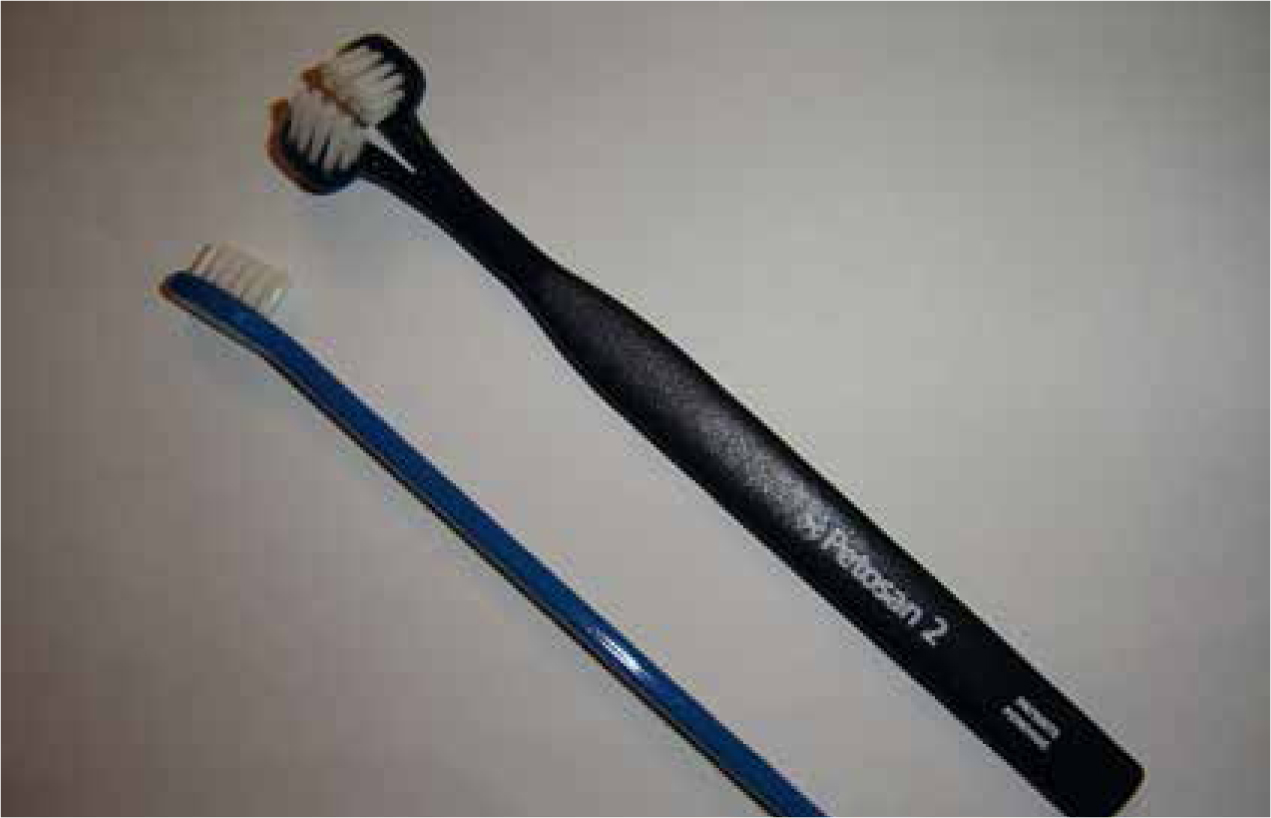
There are differing severities of gingivitis, as outlined in Table 1. If the patient has a G1 or G2 score based on these descriptors, the instigation of daily or twice daily tooth brushing will reverse the gingivitis by virtue of removing the plaque. There may be bleeding evident during the process of brushing until the gingiva have recovered from the insult, however this is completely normal and the bleeding will resolve as the gingiva return to a healthy state. It is important to advise owners that bleeding is likely to occur and explain why. Often they start brushing their pet's teeth, see blood, stop brushing and never try again, however the client must be encouraged to persist. There are tooth brushes available on the market that have black/dark coloured bristles which make the bleeding a lot less noticeable to the owners, so may improve their persistence with the intervention.
| Gingival index ‘score’ | Description |
|---|---|
| G0 (do not have to record this) | Clinically healthy gingiva. Pink (or pigmented sometimes). Form a knife-edge with the tooth. No evidence of redness or oedema. Does not bleed when gently probed |
| G1 | Mild gingivitis: slight reddening of the gingiva (‘fronding’ — tiny blood vessels may be apparent on visual inspection). Slight swelling of the gingival margin but no bleeding on gentle probing |
| G2 | Moderate gingivitis: redness and swelling of the gingival margin is obvious. Gentle probing of the sulcus often results in bleeding |
| G3 | Severe gingivitis: the gingival margin is very swollen and red/red-blue in colour. There is usually spontaneous bleeding apparent, which often becomes more profuse on gentle probing of the sulcus. Ulceration at the gingival margin may also be seen |
A score of G3 is a little more concerning. The gingival tissues have reacted very strongly to the presence of the plaque bacteria so the inflammatory response is profound. There will be bleeding and oral bacteria will be entering the bloodstream, however the veterinary professional should be most concerned about establishing whether it is just a G3 or whether there is evidence of periodontal disease as well (Baxter, 2013).
If it is just a G3 then tooth brushing will help to reverse the problem, however there will initially be considerably more bleeding than a G1 or G2, and it will take the gingival tissues longer to return to normal health. If there is evidence of periodontal disease, such as gingival recession, furcation exposure between multi-rooted teeth, deep periodontal pockets and potentially tooth mobility, tooth brushing is not going to solve the problem, and in some circumstances can be quite painful for the animal if attempted (Baxter, 2013).
Treatment of periodontal disease
The treatment of periodontal disease is dependent on the stage of the disease process and also an owner's commitment to trying and persisting with a good oral homecare regimen. The American Veterinary Dental College (AVDC) have published guidelines for the staging of periodontal disease, and have described four distinct stages (Holmstrom, 2012). It would be wise for all veterinary professionals to access and become familiar with the AVDC website contents including this staging system in clinical practice to aid their decision-making processes (AVDC, 2017). If periodontal disease is evident the veterinary surgeon must decide, following a thorough examination of each tooth with the animal under anaesthetic and with the aid of radiographs as required, whether the tooth or teeth can be saved or whether extraction is necessary; extraction is the most likely choice in general veterinary practice for diseased teeth (Holmstrom, 2012).
If the owner is able and willing to provide a high standard of oral homecare including daily or twice daily tooth brushing, the veterinary surgeon may consider leaving a tooth in situ that has a slightly deeper probing depth than is desirable, slight mobility, a little gingival recession, and a little bone loss for example. If owners can brush away the plaque on a daily basis it may be that the teeth and peridontium can be maintained in this not-perfect-yet-acceptable condition.
However, if the owner is not willing or able to instigate any form of homecare following the procedure, these slight indicators of periodontal disease become more worrying; all veterinary professionals know that, with no homecare and thus no removal of plaque, disease progression is going to be more rapid from this point onwards once the plaque has become re-established, and would typically opt to extract the tooth/teeth.
If an animal has advanced periodontal disease but the owner is absolutely dedicated to the provision of excellent oral homecare and wants to try and preserve as many of their pet's teeth as possible, referral to a dental specialist veterinary surgeon would be advised (Holmstrom et al, 2013). These specialists have the equipment, experience and expertise to perform more advanced periodontal treatments that can help to salvage the teeth and provide a better situation for the owner in terms of being able to effectively remove plaque. Such procedures include subgingival debridement/curettage and irrigation of the tooth surface and sulcus, apically repositioning the gingival margin and gingivoplasty, all of which will help to reduce sulcal pocket depths, remove bacteria effectively from more inaccessible places of the tooth, and provide the owner with better access to furcations for example so they can use small interdental brushes to remove accumulated plaque (Holmstrom et al, 2013).
Conclusion
Gingivitis is a normal, natural response of the animal's body to a noxious stimulus, and initiation of the inflammatory process is to be expected. Bacteria present within the plaque matrix/biofilm on the surface of teeth is the noxious stimulus which provokes gingival inflammation. Mechanically removing this stimulus on a daily basis is the most effective way to reduce the incidence of gingivitis, and as specified by Holmstrom et al (2013), periodontal disease begins with gingivitis that is left untreated. Simple, effective interventions should be implemented from a young age as part of a comprehensive preventative healthcare programme, and should be advised in cases of mild to moderate gingivitis, and some severe cases following thorough examination to establish that there are no additional signs of periodontal disease. Once periodontitis becomes established it cannot be reversed by tooth brushing, so a thorough examination under general anaesthetic is warranted to assess all of the teeth before the veterinary surgeon decides on a treatment plan, which will typically involve extraction of very diseased teeth or referral for more advanced periodontal therapies with a specialist.

